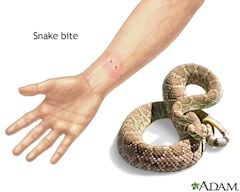Snakes
Snakebites
In areas where venomous species of snakes exist, few people ever see them, and even fewer have any real risk of being bitten. Most snakes, even the ones with the worst reputations will choose to flee when they sense your presence. Snakes usually bite as a last resort or as a quick defense against a sudden attack. Their fangs and venom evolved primarily for capture prey, not as a defense mechanism. Most snakebites in this country come as a result of people trying to handle, harass or move the snake; avoid this type of behavior and you will probably never get bitten.
How To Avoid Snakebites
Before venturing out into the wilds, familiarize yourself with the snakes of your area, both venomous and non-venomous species. Learn which habitats the venomous species in your region are likely to be encountered in, and use caution when in those habitats. Always take a buddy into the field with you. Wear boots and loose-fitting pants if you are venturing into venomous snake territory. Try as much as possible not to take a snake by surprise. Stay on trails, and watch where you place your hands and feet, especially when climbing or stepping over fences, large rocks, and logs, or when collecting firewood.
How To Treat Snakebites
- Venomous snakebites are rare,
and they are rarely fatal to humans. Of the 8,000 snakebite victims in the
United States each year, only about 10 to 15 die. However, for any
snakebite the best course of action is to get medical care as soon as
possible.
- Try to keep the snakebite victim still, as movement
helps the venom spread through the body.
- Keep the injured body
part motionless and just below heart level.
- Keep the victim warm,
calm, and at rest, and transport him or her immediately to medical care.
Do not allow him to eat or drink anything.
- If medical care is more
than half an hour away, wrap a bandage a few inches above the bite,
keeping it loose enough to enable blood flow (you should be able to fit a
finger beneath it). Do not cut off blood flow with a tight tourniquet.
Leave the bandage in place until reaching medical care.
- If you
have a snakebite kit, wash the bite, and place the kit's suction device
over the bite. (Do not suck the poison out with your mouth.) Do not remove
the suction device until you reach a medical facility.
- Try to
identify the snake so the proper antivenom can be administered, but do not
waste time or endanger yourself trying to capture or kill it.
- If you are alone and on foot, start walking slowly toward help, exerting the injured area as little as possible. If you run or if the bite has delivered a large amount of venom, you may collapse, but a snakebite seldom results in death.
How NOT to Treat a Snakebite
Though U.S. medical professionals may not agree on every aspect of what to do for snakebite first aid, they are nearly unanimous in their views of what not to do. Among their recommendations:
- No ice or any other type of cooling on the bite. Research has shown this to be potentially harmful.
- No tourniquets. This cuts blood flow completely and may result in loss of the affected limb.
- No electric shock. This method is under study and has yet to be proven effective. It could harm the victim.
- No incisions in the wound. Such measures have not been proven useful and may cause further injury.
Arizona physician David Hardy, M.D., says part of the problem when someone is bitten is the element of surprise. "People often aren't trained in what to do, and they are in a panic situation." He adds that preparation--which includes knowing in advance how to get to the nearest hospital--could greatly reduce anxiety and lead to more effective care.

